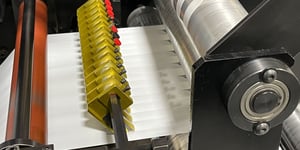You’re a few minutes into your roll slitting research when you’re forced to acknowledge the burgeoning headache in your temples, no doubt brought on by walls of unlabeled diagrams and technical explanations.
Choosing a roll slitting method might seem daunting when each technique has advantages and disadvantages that could help or harm your production. However, Strouse performs every slitting method regularly, so we’re confident in explaining the differences between techniques so you’ll know which processes suit your projects as you advance.
Understanding and comparing the differences between slitting methods will prepare you to take the final step by choosing the best process.
Log Slitting vs. Rewind Slitting
Log slitting and rewind slitting are the two primary methods of roll slitting.
When you picture cutting a roll of material, you’re likely imagining a setup similar to a lathe, where your converter mounts a massive roll on a center point and cuts thinner rolls using a spinning circular blade. This is known as log slitting and is generally a quick and easy setup.
However, rewind slitting has grown in popularity over log slitting over the years due to its versatility and tighter tolerances.
Rewind slitting involves unrolling a material, slicing it, then rewinding it into separate, smaller rolls. In addition, rewind slitting can be incorporated into an in-line process, where tape rolls are unrolled, sliced, and used for a project in one uninterrupted production line.
Unlike log slitting, rewind slitting consists of cutting a single material layer. Log slitting often becomes messy and frayed, the extent of which depends on the material and the tension at which you’re cutting it. On the other hand, rewind slitting takes longer to set up than log slitting and involves many more adjustments, which can increase the total labor time.
The Pros and Cons of Different Rewind Slitting Methods
After determining whether to use rewind slitting, you may need to decide which rewind slitting service suits your project based on cost and material.
There are three different methods of rewind slitting: shear, razor blade, and score slitting. Each technique can fit into a machine for a single in-line process or remain a standalone process.
As you learn about the different time allotments, cost, and situational use for each technique, you’ll be able to fully understand and eventually select one of the rewind slitting methods.
#1: SHEAR SLITTING
Shear slitting uses circular, interlocking blades to cut material. Similar to scissors, these knives are set at a particular angle to cut a continuous layer of unwound material.
Slitting processes often create dust or cause material strands to fray from the sides of a roll, but shear slitting produces the LEAST amount of dust, leaving you with clean and aesthetically pleasing material.
- Pros: Shear slitting often produces a cleaner result than other roll slitting methods and is highly accurate.
- Cons: Requires the most equipment, and its interlocking blades make shear slitting the most expensive rewind slitting method. The setup time is also slightly longer because the blades must be placed precisely with the right pressure.
#2: RAZOR BLADE SLITTING
Razor blade only requires razor blades, making it the most straightforward slitting process. Generally, razor blades are inexpensive and easy to set up, but they struggle with thick materials, so they’re ideal for thin films.
Mounting razor blades in the path of an unwinding material will slice it easily, yet converters will also position them over a grooved material to provide additional support
- Pros: Compared to the other types, razor blade slitting is by far the cheapest rewind slitting method due to the low cost of razor blades.
- Cons: Razor blade slitting is the messiest slitting method. It cannot handle thick materials, and it might be challenging to maintain accuracy since the blades can move.
#3: SCORE SLITTING (CRUSH SLITTING)
Score slitting uses mounted circular blades pressed against an anvil to split an ongoing stream of material.
The positioning of score slitting blades is relatively simple and easy to set up, and it can be used on a wide variety of materials. It can be extremely precise regardless of material, and will deliver consistent tolerances.
- Pros: Score slitting is a relatively simple and accurate process that works on many materials.
- Cons: There’s still a tooling cost (though not as costly as for shear slitting)
How Do I Choose A Roll Slitting Service?
Choosing a roll slitting service will depend on your purpose, material, and budget. Firstly, consider the ultimate aim of your project and whether converters can complete it in a singular production process.
If your entire production process is achievable through a single setup, you’ll save money and time by choosing rewind slitting over log slitting. Although every rewind slitting method can be performed as a standalone process, they can also fit in-line production to transform rolls of material into finished products.
Between shear, razor blade, and score slitting, the cheapest rewind slitting method is razor blade followed by score. Score slitting involves tooling, but it’s less complex than shear slitting, which leaves it in the middle regarding cost. Shear slitting is more expensive, but it grants you a cleaner look and higher accuracy.
Razor blade slitting is limited by the types of material you can use due to its flexible blades, making it a poor choice for thicker or tougher materials. Since razor blades can waiver, converters can achieve tighter tolerances from shear or score slitting.
Lastly, the setup time varies between different roll slitting methods. Log slitting has the shortest setup time, followed by razor blade slitting. Razor blade slitting is relatively fast to set up, but once again, due to the flexible blades, it could require additional adjustments throughout the process.
To find out more about what we do besides slitting, or to see our slitting specifications, check out our detailed capabilities:






